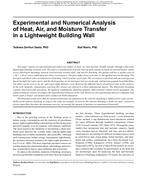Description
This paper reports on experimental and numerical studies on heat, air, and moisture (HAM) transfer through a full-scale lightweight building envelope wall. The wall is a multilayered structure built up from outside to inside of external board, vented cavity, fiberboard sheathing, mineral wool between wooden studs, and interior finishing. The global wall has a surface area of
1.80 × 2.60 m2 and is subdivided into three vertical parts. The parts differ from each other by the applied interior finishing. The first part is finished with a wooden interior finishing, which is rather vapor tight. The second part is finished with uncoated gypsum board (airtight but vapor open), and the third part has an air and vapor barrier, an air gap, and interior gypsum board finishing.
The latter can be seen as an air- and vapor-tight reference case. Between the different layers of each part and on the surfaces of the wall, humidity, temperature, and heat flux sensors are placed in a three-dimensional matrix. The fiberboard sheathing contains nine removable specimens. By regularly weighing the sheathing samples, their moisture content can be quantified. The
collected data are used to investigate the hygrothermal behavior of the wall. Moreover, the experimental data are compared with results from a Glaser calculation and a numerical HAM simulation.
The obtained results show that the amount of moisture accumulation in the exterior sheathing is influenced by vapor permeability of the interior finishing as long as the walls are airtight. As soon as the interior finishing is made air open, convective driven vapor flow becomes the dominant process, increasing the amount of moisture accumulation drastically.
Citation: Thermal Performance, International Conference, 2010
Product Details
- Published:
- 2010
- File Size:
- 1 file , 3 MB
- Product Code(s):
- D-BUILDINGSXI-72




